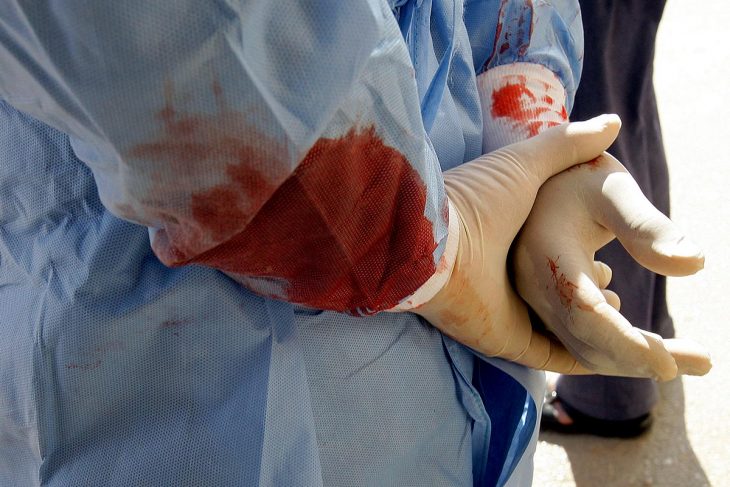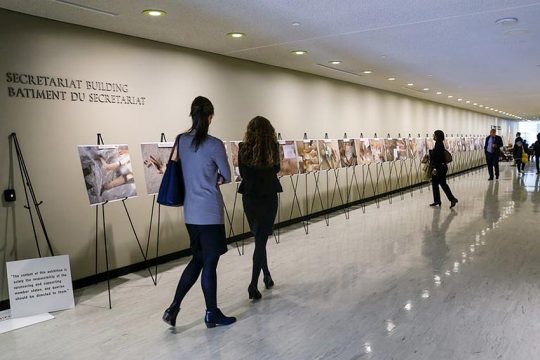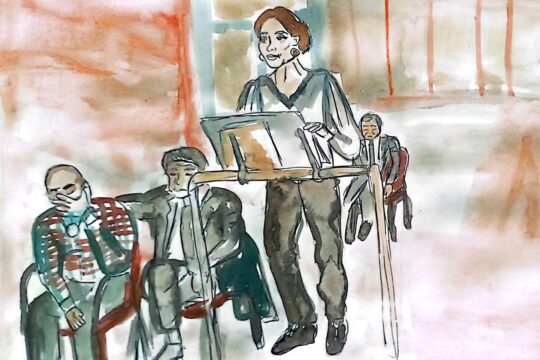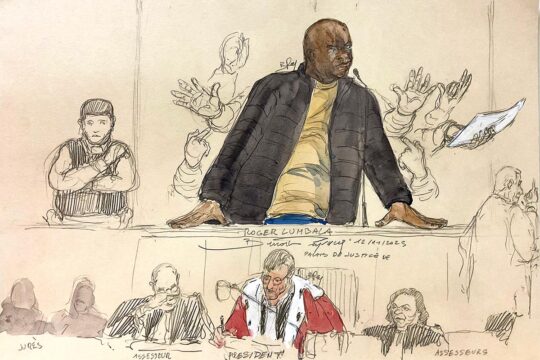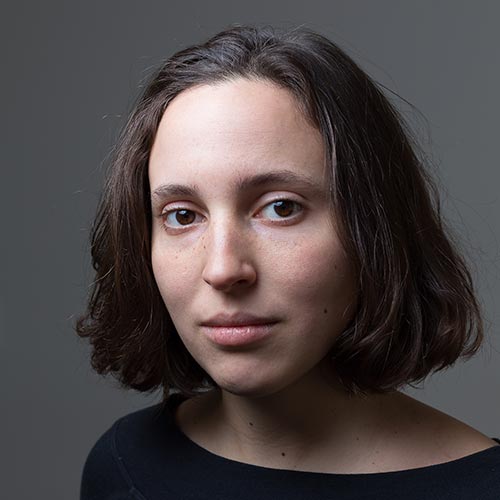Most of his patients had looked like the bodies in the infamous Caesar photos: pale with a tinge of yellow, hair unkempt, clothes old and torn. “All of them had abscesses and swellings. All of them were very thin and malnourished”, said the witness who testified in the Al-Khatib trial in Germany at the end of June. In 2012, the now 36-year-old Syrian had been working as an assistant doctor at the Red Crescent Hospital, directly opposite the General Secret Service’s Branch 251 in Damascus, also known as the Al-Khatib Branch. He and his colleagues were tasked with checking up on the detainees in the branch’s underground prison. They treated small injuries like abscesses on arms and feet, or small wounds on heads and other body parts, said the witness. But they also treated big ones, such as open wounds that exposed arteries and sinews, broken bones or limbs that had swollen to five times their normal size. “The injuries were unlike anything we had learned while studying medicine at university”, he said. “It was the first time we saw cases like these.”
In Koblenz, Germany, former secret service officer Anwar Raslan stands accused of crimes against humanity, allegedly committed in Syria. During his time as head of investigations at the Al-Khatib branch in Damascus, he is said to have been responsible for 58 killings, 4000 cases of torture and several cases of sexual violence starting in 2011, when thousands of anti-regime protesters were arrested by the secret services. More than 70 survivors, experts and secret service insiders have testified since the beginning of the trial in April 2020, but until now, medical staff has neither testified nor been mentioned much. The judges have been asking every ex-detainee in court about the issue, taking the lack of medical care into their account of the general prison conditions. Most survivors said that they had received no or hardly any medical care during their detention in branch 251 and other prisons. However, the few testimonies that did mention doctors and hospitals indicated that they had played an important role in the Syrian prison system. Some doctors, like the witness, treated tortured prisoners’ injuries, while others allegedly participated in their abuse in hospitals that became extensions of the secret services’ notorious prisons.
“If the patient was dead, our job was done”
The witness appeared in court wearing black and golden sneakers, a fanny pack, and his thinning dark hair in a ponytail. He had studied medicine in Aleppo and was then completing his obligatory medical training at the Red Crescent Hospital in Damascus. It must have been July 2012, he remembers, when officers from the Al-Khatib branch came to the neighbouring hospital and met with the administration to organize daily visits of assistant doctors to the branch’s prison. “It was during Ramadan”, he told the judges, adding that the atmosphere at work had been quiet, as many of the doctors were fasting. During their first visit to the branch, they stayed for two hours, treating more than one hundred patients. On other visits, they spent up to five hours in the underground prison. There, the officers told them how to proceed: “We were to speak to the patients about their ailments and nothing else. The patients were not allowed to tell us where their injuries came from. If they mentioned the abuse, they would be beaten immediately.” The witness and his colleagues were only able to help the prisoners to a certain extent. If someone needed antibiotics, they were allowed to give them one pill, but not the whole box. “The orders were clear“, said the witness. “Give the prisoner what he urgently needs, but nothing more.”
And then there were the deaths – almost every day, according to the witness. Some died in the branch, others at the hospital, where they had been transferred after falling unconscious. The witness said he saw at least fifty deaths with his own eyes, but that he knew from his colleagues that there had been more. “I still remember the first dead body I saw in the cell opposite the staircase”, he said, describing it as pale with a dry, white tongue, naked and barefoot. “We were not allowed to determine the cause of death”, he said. The doctors were only there to decide whether or not a patient could be treated. “If the patient was dead, our job was done.”
The witness explained that it was different with prisoners who were transferred and then died in the Red Crescent hospital. There, the doctors were allowed to determine the cause of death, which mostly turned out to be heart or kidney failure, low blood pressure due to dehydration, or sepsis as a result of injuries. This alone, however, did not reveal to them how the patients had reached their dire conditions. “We could tell that the heart had failed, but we did not know why it failed”, the witness said. He assumed that torture itself did not directly lead to inmates’ deaths, but that their overall condition combined with indirect consequences of torture, such as infection of wounds, had often been the reason. His assessment was an interesting addition to the testimony of forensic expert Marcus Rothschild in November 2020, who had analysed the Caesar photos with regard to injuries, signs and causes of death. One of his most puzzling findings had been that most of the bodies did not show any visible causes of death.
Hospitals as places of torture
Syrian hospitals were not only places where abused prisoners were taken to die, but also became places of torture themselves, as other testimonies have shown and as a witness told the Koblenz court a week later. He had worked as a clinical engineer, supplying hospitals in and around Damascus with medical devices. “The hospital had turned into a secret service branch“, he said of the Mujtahid Hospital in Damascus. “The emergency ward was full of gunmen and military personnel beating patients.” He added that injured protesters were often taken to hospitals, where they disappeared, and that this had happened to a close friend of his.
Another witness who testified at the end of last year offered one of the most harrowing testimonies of the brutal torture he suffered in different secret service branches and finally in the Harasta military hospital, which he left barely alive. He had arrived at the hospital in an already very bad condition, after having been relentlessly beaten in Al-Khatib branch, among others. At the hospital, he was chained to a bed with another inmate, in a room with about twenty more beds. “We were beaten every minute of every day”, the young man remembered. “They took turns beating us with chains and whips, knives and pipes. There were days that we spent unconscious.“ He said that he had been tortured in ways that he could not even describe. “They call it a hospital, but in reality, it is a place for torture. They take people there to kill them.“
Testimonies like these could be of interest when the German judiciary opens its next case against Syrian doctor Alaa M. About a year ago, he was arrested in the state of Hesse in Western Germany, where he was working as a doctor once again, after having arrived there from Syria in 2015. He is being investigated for crimes against humanity, allegedly committed during his time as a doctor at the military hospital of Homs, where he is said to have tortured a patient who subsequently died. The German magazine Der Spiegel also reported that he had allegedly operated on an anti-regime prisoner without anaesthesia, and set another one on fire. The indictment against him is expected soon, and the trial would start shortly after at the Higher Regional Court in Frankfurt.


